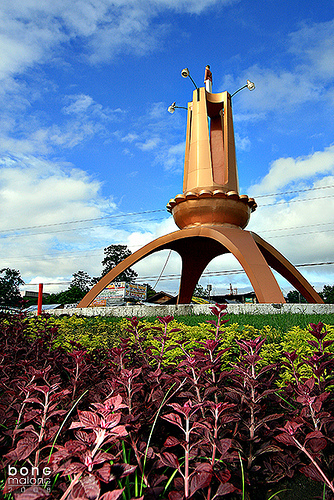 Koronadal
City, South Cotabato, locally known as Marbel, is situated in
what was called to be the Land of Promise by the pioneers and
early settlers during the times of the Philippine Commonwealth
(1935-1946).
Koronadal
City, South Cotabato, locally known as Marbel, is situated in
what was called to be the Land of Promise by the pioneers and
early settlers during the times of the Philippine Commonwealth
(1935-1946).
Rich in minerals and natural resources, these virgin lands once attracted migrants from Luzon and Visayas and that explains why the area seems to be a melting pot of cultures hailing from different parts of the country.
These lands, hardly penetrated by the Spanish conquistadores, were home of the pagan B'laan people and the Muslim Maguindanaos. Actually, the name of the place came from B'laan language, Koronadal comes from koron or kolon meaning cogon grass, and nadal or datal meaning plain, as the place was used to be a vast plains of cogon grass; the name Marbel, on the other hand, comes from the word marb-el meaning "murky waters" and must be referring to what is now called the Marbel River.
During the colonial times, missionary activities were not officially established in this area. The Jesuits only served the already Catholic regions of Northern Mindanao and some parts of the Zamboanga peninsula. They would visit from time to time a few Christian communities who were living mostly by the shorelines. Migration trends, however, during the pre-World War II era would bring about the foundations of a strong Catholic community. It was to the Oblates of Mary Immaculate (OMI) and the Passionist Fathers (CP) whom the local church looked back with gratitude. The hard labor of these missionaries came into fruition when in 1960, this thriving Catholic community has been elevated to a Prelature and in 1982 it became a full Diocese. According to the 2010 data of the local government 64.66 per cent of the present population is Roman Catholics. (http://www.southcotabato.gov.ph/general-information/)
Like anywhere else, the 1960's have become equally decisive for this humble place, while still a young prelature, the sweeping reforms of Vatican II came. But Divine Providence would keep Tradition alive in this area; thanks to Rev. Fr. Peter Rogers, a former OMI priest, who still celebrated the Tridentine Mass up to early 1990's. Upon his death on 1992, he left several faithful orphaned with no priest from the local diocese willing to continue his legacy.
Turn of events unfolded, like the hand of God working on each step, this small community of Traditionalists would finally find a safe refuge under the care of the priests of the Society of St. Pius X who were still establishing their missions Manila. Interesting anecdote of how one of the faithful, Ms. Nelly Januto, recognized the altar setup at the garage of Mrs. Evangeline Malaya's house. With the latter's help, they invited the then resident priest of the Society, Fr. Paul Morgan, to visit Marbel and offer a Mass there. This all happened in May 1993 when they first came in contact with the SSPX priests. Since then, the priests would come regularly to attend to the spiritual needs of the faithful through the Mass and the sacraments.
As a matter of fact, this tireless mission already produced several fruits of priestly and religious vocations: one of them is Fr. Albert Ghela, one of the attendees of the Traditional Latin Mass of the late Fr. Peter Rogers. He is currently serving as the Priest-in-charge of the SSPX missions in Leyte.
Today, the SSPX Marbel mission still continues with a Mass every Sunday at the chapel whose titular is St. Michael the Archangel.

Some of the youth with the District Superior, Fr. Karl Stehlin. (Source: http://catholicyouthleague.blogspot.kr/2016/05/2016-april.html)